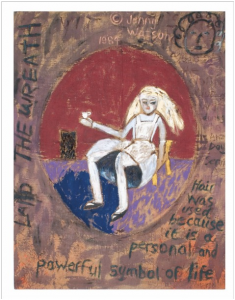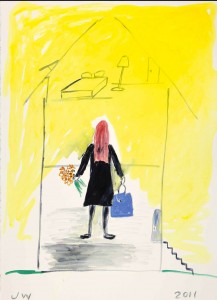As someone who keeps hopping cities, states and (most recently) countries myself I can identify with the ‘Home and Away’ theme of this exhibition. It’s been a while since I’ve seen recent work by Jenny Watson and I know she was a bit unfashionable for a while in Australia. This exhibition cleverly addresses this tall poppy experience to give a more experiential aside to the provincialism problem and the disadvantage of living far away from most major art centres and markets.
As an artist who made the switch to an international career by the 1990s, Watson’s figurative project cast in terms of biography but not reduced to it has always been a central aspect of her work. You don’t have to be an international art star to get the common ground here. Like the characters in Sophia Coppola’s film Lost in translation, the experience of being somewhere else provided a suitable sense of dislocation and estrangement, and of living in the moment that doubles the creative process, informing not only the passage but the content of the work.
As a survey show, there is a big leap from her early house portraits of Australian suburbia and views of Paris and London (like drawings for a fashion magazine) to the more casual, self-reflective recent works like A beautiful day in Delhi (2008–09) with its accompanying narrative about social dress codes and criminality. Similarly, there is an apparent change of heart from Alice in Tokyo (1984) and Australian artist in a bar in New York in 2016 (1986) to examples like Transitions: Tucson, New York, Italy, Belgium, Düsseldorf, London (2011) and 36 hours (2012), the latter starting out in Tokyo and ending up in Werribee Hospital with a dying horse. Endurance has proved Watson’s point and made many of the more academic narratives of the 1980s about the cultural cringe seem curiously sterile.
Jenny Watson: here, there and everywhere, Ian Potter Museum of Art, University of Melbourne, 18 January – 18 April 2012.



